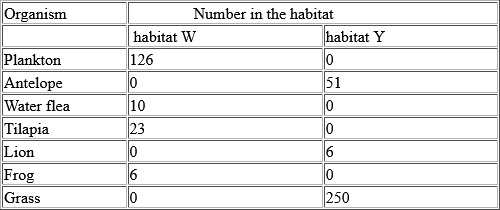Year :
2020
Title :
Biology
Exam :
WASSCE/WAEC MAY/JUNE
Paper 1 | Objectives
21 - 30 of 50 Questions
| # | Question | Ans |
|---|---|---|
| 21. |
A. unfused stigma B. fused style C. fused ovaries D. unfused anther |
C |
| 22. |
The reagent used in testing for carbon (IV) oxide is A. copper sulphate solution B. lime water C. hydrochloric acid D. sodium hydroxide solution |
B |
| 23. |
Oxygen comes out of the stomata during photosynthesis through the process known as A. diffusion B. transpiration pull C. osmosis D. active transport |
A |
| 24. |
The first stable product of photosynthesis is A. starch B. fructose C. glucose D. sucrose |
C |
| 25. |
An example of a trace elements is A. potassium B. calcium C. magnesium D. copper |
D |
| 26. |
Which of the following statements about a mixture of a protein-digesting enzyme and starch solution would be correct? The protein-digesting enzyme A. has no effect on the starch solution B. leads to the production of amino acids C. leads to the production of glucose D. digest the starch |
A |
| 27. |
The mutualism type of relationship is different from a parasitic relationship because in mutualism A. both organisms involved benefit B. none of the organisms benefits or harm each other C. both organisms harm each other D. only one of the organisms is harmed |
A |
|
The table below shows the number of some organisms in habitats W and Y. Study it to answer the question below. |
||
| 28. |
What type of habitat is W? A. Rainforest B. Pond C. Desert D. Ocean |
B |
| 29. |
Which of the following statements about habitat W is correct? The A. absence of lions and antelopes shows that the habitat is terrestrial B. presence of Tilapia and planktons shows that the habitat is not aquatic C. type of organisms present indicate that habitat is aquatic D. absence of grasses indicates that the habitat is terrestrial |
C |
| 30. |
The number of lions and antelops in habitat Y shows that the lion A. is the prey while the antelope is the predator B. is the predator while the antelope is the prey C. and the antelope are preys to each other D. and the antelopes are predators |
B |
| 21. |
A. unfused stigma B. fused style C. fused ovaries D. unfused anther |
C |
| 22. |
The reagent used in testing for carbon (IV) oxide is A. copper sulphate solution B. lime water C. hydrochloric acid D. sodium hydroxide solution |
B |
| 23. |
Oxygen comes out of the stomata during photosynthesis through the process known as A. diffusion B. transpiration pull C. osmosis D. active transport |
A |
| 24. |
The first stable product of photosynthesis is A. starch B. fructose C. glucose D. sucrose |
C |
| 25. |
An example of a trace elements is A. potassium B. calcium C. magnesium D. copper |
D |
| 26. |
Which of the following statements about a mixture of a protein-digesting enzyme and starch solution would be correct? The protein-digesting enzyme A. has no effect on the starch solution B. leads to the production of amino acids C. leads to the production of glucose D. digest the starch |
A |
| 27. |
The mutualism type of relationship is different from a parasitic relationship because in mutualism A. both organisms involved benefit B. none of the organisms benefits or harm each other C. both organisms harm each other D. only one of the organisms is harmed |
A |
|
The table below shows the number of some organisms in habitats W and Y. Study it to answer the question below. |
||
| 28. |
What type of habitat is W? A. Rainforest B. Pond C. Desert D. Ocean |
B |
| 29. |
Which of the following statements about habitat W is correct? The A. absence of lions and antelopes shows that the habitat is terrestrial B. presence of Tilapia and planktons shows that the habitat is not aquatic C. type of organisms present indicate that habitat is aquatic D. absence of grasses indicates that the habitat is terrestrial |
C |
| 30. |
The number of lions and antelops in habitat Y shows that the lion A. is the prey while the antelope is the predator B. is the predator while the antelope is the prey C. and the antelope are preys to each other D. and the antelopes are predators |
B |
